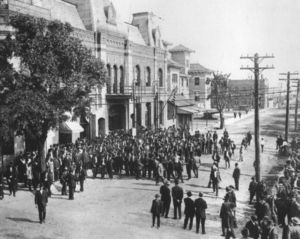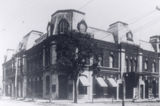Pensacola Opera House
| Pensacola Opera House | |
 Crowd outside Opera House on Jefferson Street | |
| Building Information | |
|---|---|
| Location | Jefferson Street at Government |
| Client | Daniel F. Sullivan |
| Engineer | A.V. Clubbs, contractor Theodore Weber, artist L. C. Bennett, brickwork |
| Completion Date | 1883 |
| Date Demolished | 1917 |
| Size | 1,400 seats |
The Pensacola Opera House was a 1,400-seat theater at the intersection of Jefferson and Government Streets, across from Plaza Ferdinand VII. Financed by timber magnate Daniel F. Sullivan, it opened on January 4, 1883. The building was heavily damaged in the two 1916 hurricanes and demolished after receiving further damage from the Hurricane of 1917. Salvaged bricks and balcony railings were used in the construction of the Saenger Theatre.
Contents
Design
The 1885-1886 Pensacola City Directory says the following of the Opera House:
- The Pensacola Opera House, Government cor Jefferson. R. F. McConnell, Manager, Sullivan's Wharf. This Opera House has two tiers above the main floor, is supplied throughout with opera chairs, and has a seating capacity of 1400 people. The stage which is 50 x 60 feet has 15 sets of scenery, foot-lights and four boxes. The rent is $100 per night.[1]
Occie Clubbs further describes it in a 1959 article in the Florida Historical Quarterly:
- This was a two-story structure of brick with mansard roof, reaching a height of sixty feet, and extending 105 feet on Jefferson Street and 145 feet on Government. The lower floor or parquet is very capacious and with a magnificent dome over-head lit by a chandelier with numberless gasjets will present an animated appearance. There is a vestibule in front of each gallery landing for gentlemen to lounge entre-acts, and cloakrooms for the ladies who come in full dress. The seating capacity is about 1200 and the building will be lighted by a 2000 light gas machine. There are four boxes and the floor is covered with velvet carpet and the wrought iron rail is covered with red plush." [2]
According to the trade magazine Boxoffice:
- The second, or "peanut" gallery was set aside for Negroes, and a section of 15 seats was reserved for the demimondaine of the town (them's the naughty gals, kids).[3]
Guest Performers
Some of the performers who graced the Opera House during its existence include:
Meeting place
In addition to being a performance venue, the Opera House also hosted political rallies, public meetings, and other events. In 1908, striking streetcar workers held a rally at the Opera House. In 1912, Booker T. Washington spoke at the Opera House during a visit to Pensacola.
Bank
In addition to the theater itself, the Opera House also housed the Sullivan brothers' First National Bank, accessible through an entrance at the building's northwest corner. When that bank changed locations, the space was occupied by the American National Bank.
Pensacola Advertising Company
In 1902 then-owner John M. Coe created the "Pensacola Advertising Company," a small poster business to promote the opera house. He took a business partner, Charles W. Lamar, Sr., in 1905. When the two men dissolved their business relationship in 1908, the poster company went to Lamar and was renamed Lamar Advertising. According to Lamar company lore, "a coin toss was used to divide their assets," and Lamar "lost."[4] Of course, the opera house was destroyed eight years later, while Lamar Advertising went on to become a billion-dollar multinational.
Other images
Circa 1883, housing First National Bank
The opera house as seen from Plaza Ferdinand VII
From Plaza Ferdinand VII, circa 1910
References
- ↑ [1] Courtesy Janet Myers.
- ↑ Clubbs, Occie (January 1959). "Pensacola in Retrospect: 1870-1890". Florida Historical Quarterly, p. 385-387.
- ↑ "Compiling State Theatre History." Boxoffice, July 6, 1946.
- ↑ Lamar Company History






